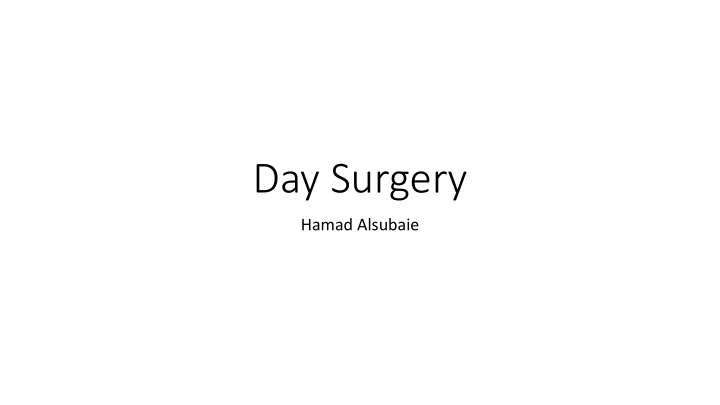

Day Surgery Hamad Alsubaie
• Day surgery is defined as a patient being admitted to hospital for a planned procedure and discharged home the same calendar day.
• The day surgery pathway • Successful day surgery outcomes are largely dependent on three key factors: The main aspects of a successful day surgery pathway are shown below • day surgery enthusiasts • a robust day surgery pathway • motivated patients
• Patient selection • There are very few absolute contraindications. • To achieve the goals of patient selection, one needs to ask three broad questions: • Is the operation an appropriate day-case procedure? • Is there anything we would do for this patient by admitting them overnight which could not be done at home? • Are the patient's home circumstances adequate for day surgery discharge?
• Surgical factors • The procedure should not have significant risk of major postoperative complications necessitating immediate medical intervention (haemorrhage, cardiovascular instability). • No prolonged specialist postoperative care or observation required.
• Abdominal and thoracic cavities should only be opened with minimally invasive techniques. • Postoperative pain should be controllable with oral analgesia ± regional anaesthesia techniques. • Patient should be able to rapidly resume normal functions (oral nutrition, safe mobilization). • Urgent procedures are also appropriate for a semi-elective day-case pathway, for example, drainage of abscesses, some trauma surgery.
• Medical factors • Patient's fitness for day surgery should be judged by functional assessment at the time of preoperative assessment • Patients with stable chronic medical conditions such as diabetes, asthma, or epilepsy are often better managed with minimal disruption to their daily routine as facilitated by day surgery. • Patients with unstable medical conditions such as unstable angina or diabetes are unlikely to be appropriate for day surgery.
• Obesity: Obese patients benefit from day surgery management with its short-acting anaesthetics and early mobilization. Even morbid obesity is not a contraindication to day surgery. While technically challenging, the majority of complications occur during the procedure or in first-stage recovery and resolve early in the recovery period. An overnight stay is unlikely to confer any benefit and in fact day-case bariatric surgery is a developing area • The elderly: There is no upper age limit for day-case surgery. Increasing age does not lead to adverse day surgery outcomes 3 and being in their familiar home surroundings may reduce postoperative cognitive dysfunction.
• Social factors • 24 h home care: It is generally recommended that after a general anaesthetic, most patients should have a responsible adult to accompany them home and remain with them for 24 h after surgery • Access to a telephone. • Geographical proximity to hospital; travelling time >1 h may be contraindication for certain procedures (e.g. day-case tonsillectomy). • The patient must understand, engage with, and consent to the surgical procedure and for it to be performed as day surgery.
• Preoperative preparation • Successful day surgery outcomes require good preoperative preparation. • Education of patients and carers about day surgery pathways. • Helping patients to make informed decisions by providing verbal and written information regarding planned procedures and postoperative care. • Identification of any medical risk factors and optimizing medical conditions before surgery.
• Anaesthetic management • rapid onset and offset of anaesthesia with clear-headed emergence, • minimal postoperative nausea and vomiting (PONV), dizziness, or drowsiness, • rapid return to full cognitive functions.
• Analgesia • Regular oral analgesia with paracetamol combined with long-acting non-steroidal anti-inflammatory drugs, if not contraindicated. • Supplementation with local or regional anaesthesia where possible. • Avoidance of any long-acting opiates and judicious use of short-acting opiates if required for management of acute pain.
• Postoperative nausea and vomiting PONV should be risk assessed before operation and prophylactic anti- emetics given to patient stratified at high risk. Policies should also exist for the rapid management of any postoperative PONV as this can significantly delay discharge. The routine use of i.v. fluids can enhance a patients feeling of well-being and reducing PONV. 9
• Postoperative recovery and discharge • During the postoperative period, patients should be actively encouraged to return to their preoperative physiological state • Phase I: early recovery, from end of anaesthesia until the return of protective reflexes and motor function. • Phase II. During this time, the patient meets the recovery milestones and achieves the criteria for discharge.
• Patients should only remain in phase 1 recovery as long as is necessary to retain full consciousness and have immediate analgesic requirements met. • Discharge from phase 1 recovery should be criteria rather than time based and in the most efficient units, patients may spend no longer than 5 – 10 min in the phase 1 recovery area.
• Discharge • Nurse-led discharge is key to day surgery and should include: • Timely discharge once all the recovery milestones have been met • Appropriate analgesia with written instructions given to the patient
• A discharge summary should they require medical assistance overnight. • A telephone number where patients can access advice from a senior nurse overnight should they require it. This person must be able to give advice relating to complications of the surgical procedure undertaken.
Thank You
Recommend
More recommend